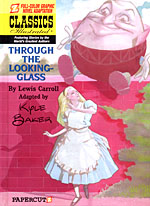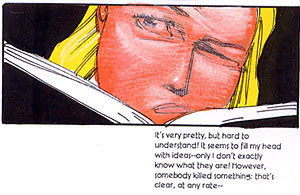 Adapted by Kyle Baker
Adapted by Kyle Baker
Based on the novel by Lewis Carroll
64 pages, color
Published by Papercutz
I have a strange confession to make; when it comes to Lewis Carroll’s two books about Alice, my favorite isn’t Alice’s Adventures in Wonderland. Rather, it’s the second book, Through the Looking Glass and What Alice Found There, that always intrigued me more, with Alice’s journey across a chessboard in an attempt to become a Queen instead of a Pawn. When Papercutz had Kyle Baker’s adaptation of Through the Looking Glass (originally published by First Comics in 1990) on their schedule, I was excited. Kyle Baker? Through the Looking Glass? How could this possibly go wrong?
 Bored one afternoon, Alice decided to climb through the looking glass in the parlor, and explore the looking-glass world on the other side. What she found there was a massive chess game in progress, with people serving as the pieces and journeying across massive squares. If Alice can make it all the way to the Eighth Square, there she will become a Queen. But even if she can finish her trip there amidst Tweedledum, Tweedledee, White and Red Queens, Humpty Dumpty, and the Lion and the Unicorn, will she like what is awaiting her at the end of the game?
Bored one afternoon, Alice decided to climb through the looking glass in the parlor, and explore the looking-glass world on the other side. What she found there was a massive chess game in progress, with people serving as the pieces and journeying across massive squares. If Alice can make it all the way to the Eighth Square, there she will become a Queen. But even if she can finish her trip there amidst Tweedledum, Tweedledee, White and Red Queens, Humpty Dumpty, and the Lion and the Unicorn, will she like what is awaiting her at the end of the game?
The prose version of Through the Looking Glass is almost more a series of connected short stories than one massive plot, each square being its own unique entity that Alice explores. It’s full of wordplay of all sorts, from odd poems to strange words, as Carroll delights in everything that the English language provides. And while there’s an episodic nature to Through the Looking Glass, each does contribute to Alice’s overall journey, as well as feeling distinct and individual from one another.
 In other words, that’s everything that this adaptation seems to partially lose somewhere along the way. It’s frustrating, because Baker seemed like the perfect choice for this adaptation; maybe if he’d created it now instead of almost two full decades ago, we’d have ended up with a much stronger book. But this, though, just isn’t quite there. Baker uses his old storytelling style of panels with dialogue printed beneath them (like The Cowboy Wally Show or Why I Hate Saturn). While it works great in creations of Baker’s own, it doesn’t seem to quite carry the story here. Maybe it’s because there was so much that Carroll brought to the actual prose itself, that cutting it entirely seems like a drastic mistake; if there was ever an adaptation that called for including some of the descriptive prose in narration boxes, this was it.
In other words, that’s everything that this adaptation seems to partially lose somewhere along the way. It’s frustrating, because Baker seemed like the perfect choice for this adaptation; maybe if he’d created it now instead of almost two full decades ago, we’d have ended up with a much stronger book. But this, though, just isn’t quite there. Baker uses his old storytelling style of panels with dialogue printed beneath them (like The Cowboy Wally Show or Why I Hate Saturn). While it works great in creations of Baker’s own, it doesn’t seem to quite carry the story here. Maybe it’s because there was so much that Carroll brought to the actual prose itself, that cutting it entirely seems like a drastic mistake; if there was ever an adaptation that called for including some of the descriptive prose in narration boxes, this was it.
The adaptation also comes across as very choppy, jerking from one scene to the next with almost no transition whatsoever. It’s hard to tell how Alice is getting from one place to the next—there are times when if you blink you’ll miss what little transition there in fact is—and it results in a very confusing final product. The scenes with Alice and the Sheep are supposed to have a store that at one point transforms into a boat, slowly but with no real warning, and in the original book it’s strange and eerie. Here, the shop is abruptly swapped out with a boat, coming across more like Baker made a mistake than something that was deliberate. It probably doesn’t help that Baker uses most of his art to focus very tightly on a character’s face, so that you can’t see what else is going on at the same time. Don’t get me wrong, I think his portraits of the characters make up the strongest part of the book and I think he does them really well, but it’s also at the sacrifice of everything else needed to make Through the Looking Glass hold together.
It really is a pity that we aren’t getting Baker adapting Through the Looking Glass now; he’s come so far as a creator that I can’t help but think he’d have approached this in a different, and stronger way. Instead this serves at best as a curiosity of an earlier time, and experiment that just doesn’t quite work. Lots of little individual pieces are good—I love the poems running alongside the illustrations of the Walrus & the Carpenter, as well as the facial expressions of Alice as Humpty Dumpty reads his own poem to her—but as a whole it’s just not quite there. It’s a real shame; this classic of literature really deserves better.
Purchase Links: Amazon.com
